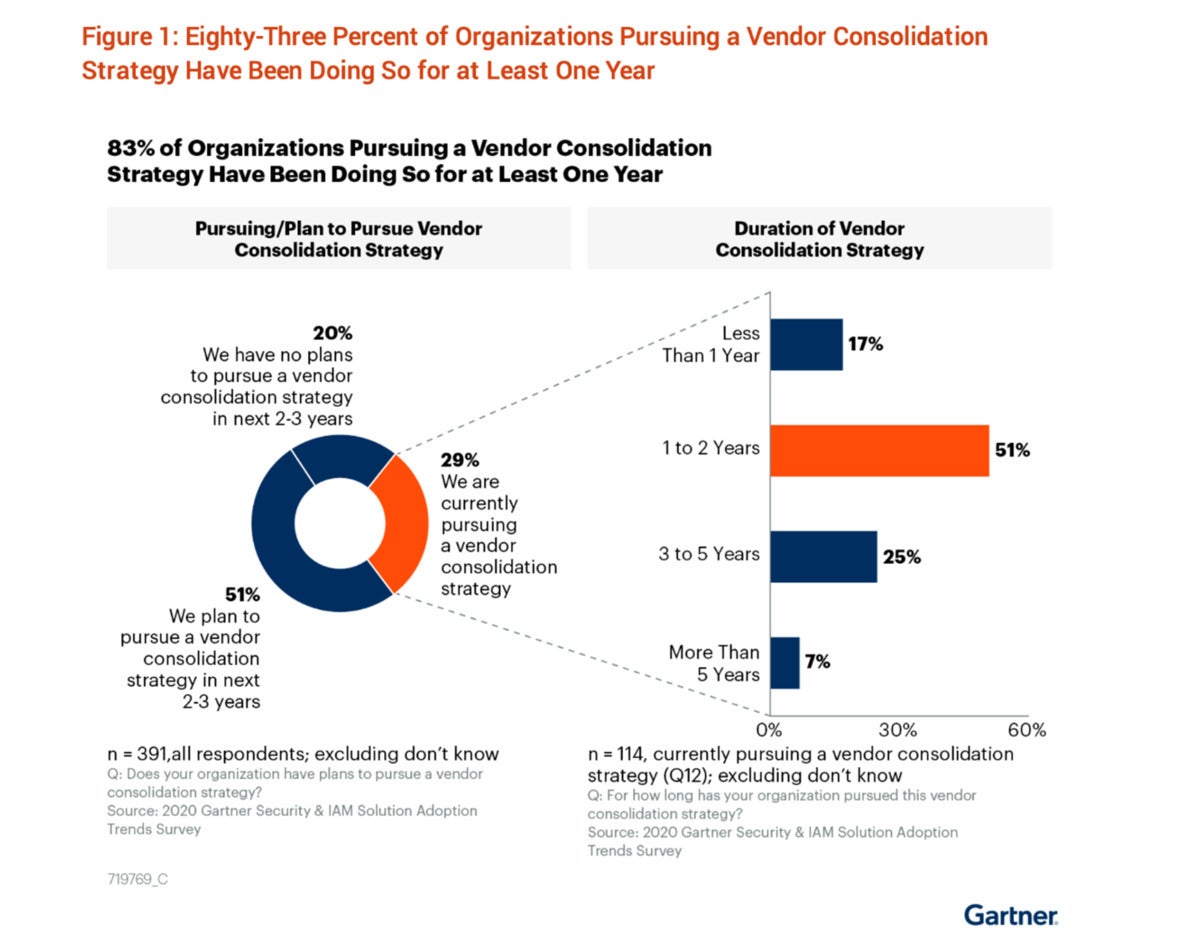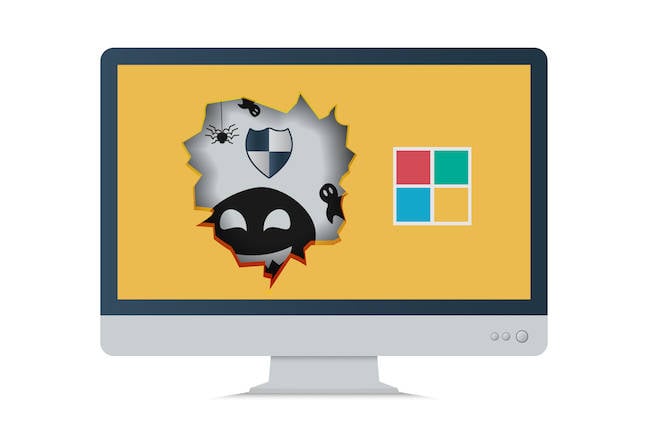Managing multiple security vendors is proving to be a significant challenge for organizations, leading to difficulties in integration, visibility, and control. Recent surveys and reports have identified numerous problems associated with managing an assortment of security products from different vendors, and that managing multiple vendors was cited as the top challenge in achieving an effective security posture.
"Simplicity is the ultimate sophistication." - Leonardo da Vinci
To mitigate security risks, one effective approach is to consolidate vendors. This strategy can enhance security management, simplify operations, and reduce complexity. In this article, we evaluate the risks of managing numerous security tools and solutions, as well as the benefits of vendor consolidation.
Recent report by Gartner, Inc. found that 75% of organizations – that’s 3 out of 4 companies today - are pursuing security vendor consolidation in 2022, up from just 29% in 2020. It's encouraging to note from this report that companies are placing a greater emphasis on improving their overall security and operational efficiency through consolidated solutions, rather than being solely driven by cost optimization.
Let’s evaluate the risks around multi-vendor environments and why CSOs must accelerate consolidation of cybersecurity solutions to help alleviate the burden of managing tool sprawl and multiple providers.
Key Security Risks in Multi-Vendor Environments
Complexities in Deployment and Management
Dealing with multiple vendors in cybersecurity can be highly complex, as it demands additional time and effort to manage multiple systems and interfaces, making it challenging to troubleshoot issues promptly during incidence response. Furthermore, consolidating vendors may require you to hire or train staff to manage the new security solutions. Different vendors often have unique interfaces and workflows, which can make it necessary for staff to learn and master multiple systems. All these factors contribute to an increase in the total cost of ownership, including the cost of hiring and training staff, which can further strain an organization's resources.
Inadequate and Inefficient Integrations
Each vendor may have different integration methods, which can lead to compatibility issues and make it difficult to create a cohesive security architecture. Integration problems can cause delays in response time and create blind spots in monitoring and alerting. In addition, incompatibility issues can arise when using products from different vendors, which can cause communication breakdowns between different systems, leading to a potential for vulnerabilities.
Compliance and Regulatory Hurdles
Multiple vendors can make it difficult to maintain compliance with industry standards and regulations. It is a challenging task for organizations to verify multiple vendors and solutions compliance with industry standards and regulations. Some of the risks include varied regulatory requirements for data protection and privacy, complex legal and contractual arrangements, inconsistent security controls, and difficulty in maintaining consistent data governance policies.
Advantages of Vendor Consolidation
Considering the potential risks and security gaps mentioned earlier, it's important to address the unique challenges of cloud native security. Consolidating vendors offer numerous benefits. You can increase visibility and monitor security more effectively, improve integration between systems, reduce complexity, standardize security practices, and simplify training and support.
As validated by the Gartner survey, vendor consolidation is expected to improve the risk management posture of 65% of organizations.
 Cisco
CiscoBy 2025, 70% of organizations will consolidate the number of vendors securing the life cycle of cloud-native applications to a maximum of three vendors.
- Gartner
In cloud-native environments, a consolidated security platform is critical due to the constantly evolving attack surface. Traditional security tools may not be sufficient for detecting and responding to sophisticated threats. Here's how you can significantly strengthen your organization's security posture:
Holistic Platform for Visibility, Monitoring, and Remediation
A unified platform provides a centralized view of security posture and enables monitoring of all cloud-based workloads, applications, and services. It also offers enhanced automation capabilities to manage security at scale, freeing up security teams to focus on higher-level tasks. Overall, a consolidated platform is essential for effective security strategy in cloud-native environments, providing better visibility, faster incident response, and greater scalability.
Increased
A consolidated platform provides a streamlined workflow for security teams, allowing them to manage and monitor all security events from either a single console or a closely integrated solution stack offered by a single vendor. This is not only critical for effective threat detection and response, but also results in spend less time on administration and sifting through various sources of data to get a complete picture of a security incident, which can be time-consuming and error prone. In addition, it fosters seamless teamwork and collaboration among cross-functional teams responsible for troubleshooting and resolving these issues. This includes DevOps, SRE, Security, Developers, and Cloud Platform teams.
Comprehensive Protection Across Emerging Attack Surfaces
Cloud migration requires a holistic application-first security approach, covering diverse security controls for hybrid environments. Cloud-native environments like bare metal, VMs, containers, and serverless functions offer benefits like agility and cost savings but also create new attack surfaces that need to be secured. Securing each environment with different security solutions offered by cloud providers and vendors may not integrate well, making it difficult to get a unified view of the overall security posture. With effective vendor consolidation, organizations can adopt a holistic approach to security that includes building security into the application development process, using automation tools, implementing a DevSecOps culture, and using security solutions that work seamlessly across different cloud-native environments.
Tips on Vendor Consideration
Vendor consolidation involves choosing a limited number of cybersecurity solution providers, which requires trust in their reliability, effectiveness, and security. Trust is a critical factor in this context, and confidence in vendors' ability to provide dependable solutions is essential for successful vendor consolidation. It is advisable to select vendors with a track record of successful partnerships to establish a strong and long-term relationship. To encourage widespread adoption of security measures, it's crucial to look for solutions that are easy to use and integrate into existing systems.
Overall, a consolidated security platform is an essential component of an effective security strategy for cloud-native environments, providing better visibility, faster incident response, and greater scalability than traditional security tools.
Why Cisco?
As a networking and security industry leader, Cisco has an unrivaled security portfolio and expertise. Cisco is driven to secure every connection, providing end-to-end protection for users and devices across multiple clouds and networks with a seamless experience. Cisco’s Security Cloud, built on a robust, flexible portfolio of security technologies, backed by the unparalleled threat intelligence of Cisco Talos, delivers this expertise via one coordinated, automated system for faster, more efficient protection across all your infrastructure. As we continue to build towards the Cisco security solutions to enhance organizational resilience for a multi-cloud world, the latest innovations from Cisco's Emerging Technologies and Incubation (ET&I) team address the connectivity observability and security challenges facing modern application development and operations. Cisco is bringing together various controls in the Cisco portfolio, that help secure everything from the cloud infrastructure that hosts applications, to applications themselves using cloud native and run-time security solutions.
.png)
 1 year ago
65
1 year ago
65 















 Bengali (Bangladesh) ·
Bengali (Bangladesh) ·  English (United States) ·
English (United States) ·